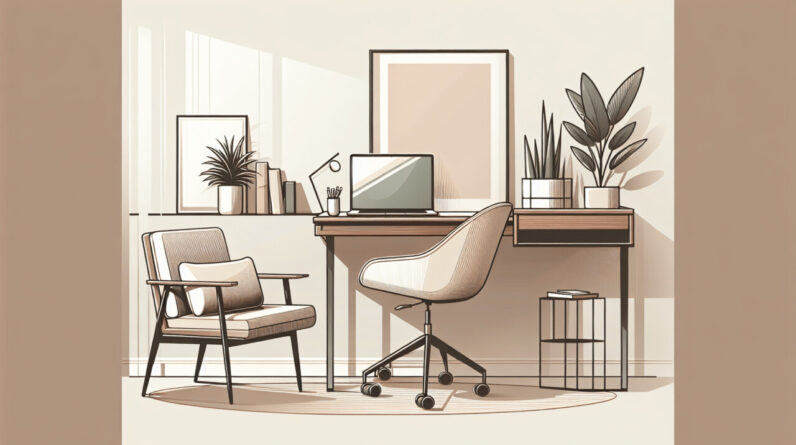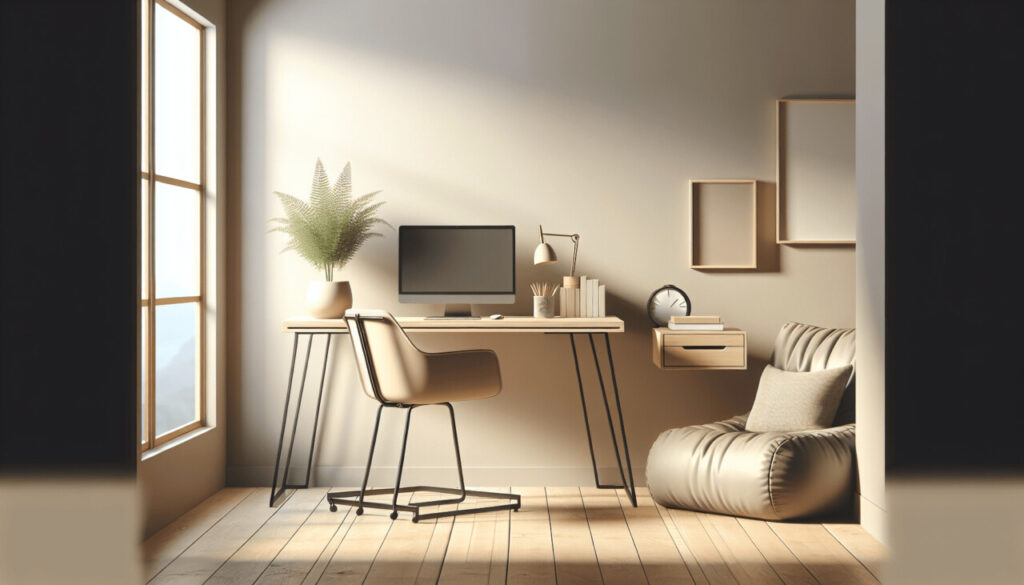
What if you could create a workspace at home that boosts your productivity, keeps you motivated, and makes you feel good while you work? Setting up a remote workspace effectively is key to not only achieving your professional goals but also maintaining a healthy work-life balance. Let’s walk through the essential steps to create an efficient home office.

Table of Contents
Understanding Your Needs
Before you start gathering furniture and office supplies, it’s important to assess your unique needs. Each individual has different work requirements based on their job and personal preferences.
Identify Your Work Style
Consider how you work best. Are you someone who thrives in absolute quiet, or do you prefer a bit of background noise? Some people like sitting at a desk, while others are comfortable working from a couch or even standing. Understanding your work style will help you create a space that encourages productivity and comfort.
Define Your Daily Tasks
Take a moment to think about your daily tasks. Will you be on video calls regularly? Do you need space for paperwork or creative projects? Defining your tasks can help you set up a workspace that meets all of your functional needs.
Choosing the Right Location
The location of your workspace plays a significant role in your overall efficiency.
Find a Quiet Spot
To minimize distractions, look for a quiet corner of your home. Ideally, this spot should have limited foot traffic and interruptions. A spare bedroom or a quiet nook in the living room might be perfect for you.
Consider Natural Light
Natural light can greatly impact your mood and energy levels. Try to place your workspace near a window to take advantage of sunlight during the day. A well-lit space reduces eye strain and enhances your focus.
Selecting Essential Furniture
Once you’ve identified your workspace location, it’s time to think about the furniture. The right furniture can make a big difference in your comfort and productivity.
Investment in an Ergonomic Chair
An ergonomic chair is an investment in your health. Look for one that supports your back and promotes good posture. Spending long hours in front of a computer can lead to stiffness and discomfort, so prioritize finding a chair that suits your body well.
Choose a Functional Desk
Your desk should cater to your work habits. If your tasks often involve a computer, make sure the desk has enough surface area for your laptop or monitor, as well as any additional items you may need, like a notepad, planner, or coffee cup.
Utilize Multiple Surfaces
Consider a desk that allows for different work surfaces or even an adjustable standing desk. Some days, you might want to sit, and other days, you may feel energized standing. Having that flexibility can keep your routine fresh.
Organizing Your Workspace
A well-organized workspace can help reduce stress and improve focus. Clutter can be a significant productivity killer, so let’s look at some organizing tips.
Invest in Storage Solutions
Capture the chaos with proper storage solutions. Bookshelves, filing cabinets, and drawer organizers can help keep everything tidy. You don’t need to overload your desk with items; instead, designate specific areas for various tools and supplies.
| Item | Purpose | Recommendation |
|---|---|---|
| Desk Organizer | Keep small items in reach | Multi-compartment holder |
| File Cabinet | Store important documents | Lockable for privacy |
| Bookshelf | Display books and decor | Adjustable shelves |
Create Zones
Divide your workspace into zones based on tasks. For example, separate areas for computer work, paperwork, and brainstorming can help you mentally shift gears when needed.
Maintain a Minimalist Approach
While it may be tempting to showcase personal items or knick-knacks, remember to maintain a minimalist approach to keep distractions at bay. Consider only displaying a few meaningful items that inspire you.

Setting Up Technology
In today’s digital environment, technology plays a vital role in remote work. Therefore, ensuring that you have the right tools is crucial.
Reliable Internet Connection
A stable internet connection is a fundamental necessity for remote work. Consider investing in a high-speed plan that fits your usage requirements to avoid lagging during important video calls or heavy uploads.
Necessary Devices
Invest in the necessary devices like a laptop or desktop computer, a good quality webcam, and a microphone. Additionally, consider peripherals like an external keyboard and mouse for comfort and efficiency.
Use Software Tools
Finally, select the right software tools to streamline your work. Whether it’s project management, communication apps, or file storage, having the right tools can help improve your workflow.
Personalizing Your Space
Incorporating personal touches can make your workspace feel inviting and motivating.
Add Your Favorite Decor
Consider adding personal decorations that reflect your personality. A framed photo, artwork, or plants can create a pleasant environment that brings joy during your workday.
Create a Vision Board
A vision board can serve as a motivational tool. Pinning images or quotes that inspire you can help you keep your goals in sight and fuel your ambition.
Ensure Comfort with Soft Furnishings
Incorporating a cozy blanket or cushion can make your space feel warm and inviting. It encourages you to stay comfortable and enjoy your time in the workspace.
Establishing a Routine
A well-established routine can help transition your mindset into work mode.
Define Work Hours
Set specific working hours to help differentiate between work and personal time. This structure can prevent work from bleeding into your personal time, fostering a better work-life balance.
Take Breaks
Taking regular breaks is essential for maintaining productivity. Plan short breaks between tasks to refresh your mind and prevent burnout.
Follow a Morning Ritual
Consider implementing a morning ritual to signal the start of your workday. Whether it’s a cup of coffee, light stretching, or reading an inspiring article, creating this ritual can help set a positive tone for the day.
Implementing a Good Workflow
Let’s take a look at how to establish an effective workflow that keeps you on track throughout the day.
Use To-Do Lists
Creating a to-do list can help you prioritize tasks based on importance and deadlines. Write down your tasks at the beginning of the day and check them off as you complete them.
Time Management Techniques
Consider using techniques like the Pomodoro Technique, which involves working for a set period (like 25 minutes) followed by a short break. This method can enhance focus and create a sense of urgency, optimizing your productivity.
Limit Distractions
Identify your biggest distractions and address them proactively. Whether it’s putting your phone on silent or using website blockers to avoid social media, find ways to stay focused on your tasks.
Creating an Ergonomic Setup
Your setup should promote addressing your physical well-being while working long hours.
Proper Desk Height
Your desk should be at elbow height so that your arms can move comfortably while typing. Ensure your monitor is at eye level to prevent straining your neck.
Footwear Choices
If you work in a standing position, wear supportive shoes or consider using a cushioned mat. For seated tasks, you might find it comfortable to remain barefoot or wear light footwear.
Stretch Regularly
Incorporate stretching into your routine. A few simple stretches can rejuvenate your body, improve circulation, and enhance your focus.
Maintaining Work-Life Balance
Establishing a remote workspace should also involve creating boundaries to maintain a healthy work-life balance.
Set Boundaries With Family or Roommates
If you share your space, communicate your work hours clearly. Consider using visual cues such as a “do not disturb” sign when you’re in the zone, signaling your need for focus.
Create a Sign-Off Ritual
At the end of your workday, implement a sign-off ritual to connect to your personal time. This could be as simple as shutting your laptop, clearing away your workspace, or changing your clothes. This ritual helps reinforce the end of the workday.
Performing Regular Assessments
Periodically reviewing your workspace can lead to continuous improvements.
Reflect on Your Setup
Every few months, take some time to reflect on your workspace. Ask yourself what’s working well and what could be improved. Sometimes even a minor tweak can lead to significant changes in your productivity.
Keep Up With Trends
Stay informed about evolving trends in remote workspaces. Often, new tools or techniques can emerge that may enhance your efficiency and well-being.
Adjust Your Space as Needed
As your work evolves, so should your workspace. Be open to making changes to suit your developing needs, whether it’s upgrading technology or altering your furniture layout.
Conclusion
Crafting an efficient home office is not just about aesthetics; it’s about creating a space that supports your productivity and maintains your well-being. Take the time to evaluate your needs, organize your tools, and personalize your workspace. These efforts will not only make your remote work experience fruitful but will also help you thrive in today’s dynamic work environment. Happy working!










